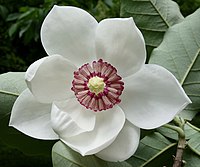
Photo from wikipedia
A woman with Fitzpatrick skin phototype IV and hypothyroidism developed pruritic macular hyperpigmentation with punctate hypopigmentation symmetrically on her forehead (Figure 1A) at age 45 which she related to hair… Click to show full abstract
A woman with Fitzpatrick skin phototype IV and hypothyroidism developed pruritic macular hyperpigmentation with punctate hypopigmentation symmetrically on her forehead (Figure 1A) at age 45 which she related to hair dyes. Gradually, the hyperpigmentation spread to the temples, preauricular areas, and upper lip. Melasma was suspected and treated with hydroquinone plus sunscreens. Pigmentation, however, progressively darkened and spread to the armpits, groin, retroauricular areas, and dorsal aspects of hands and feet. A biopsy showed lichenoid infiltrates around pilosebaceous units with Civatte bodies and melanophages, features compatible with LPP. Topical depigmenting agents (glycolic acid and kojic acid), calcipotriol, topical and oral corticosteroids, griseofulvin, laser, and hydroxychloroquine were applied without success and were suspended. Four years later, she experienced frontotemporal hairline recession associated with eyebrow, forearm, pubic, leg and axillary hair loss clinically compatible with FFA. Hyperpigmentation thereafter spontaneously improved in the face and completely resolved elsewhere. Subsequently, at the age of 58, she presented with acute facial eczema (Figure 1B). Patch tests showed positive reactions to nickel sulfate, cobalt chloride, propolis, gallates mix, dodecyl gallate, ethylhexyl salicylate, and two personal cosmetics “as is” (Eucerin Hyaluron-Filler + Volume-Lift Day and Lift Eye Cream [Beiersdorf, Hamburg, Germany]; Table S1). Repeated open application test (ROAT) performed at the inner side of the lower arm was intensely positive at day (D)7 with both cosmetics. Patch tests with their individual ingredients provided by the manufacturer only showed positive weak reactions with Magnolia officinalis bark extract (MOBE) 0.5% pet. present in both creams. Individual ingredients reapplied on D5 occluded for 3 days, yielding a more pronounced reaction to MOBE 0.5% pet. ROAT with MOBE 0.5% pet. was also intensely positive after the fifth application (Figure 2; Table S1).
Journal Title: Contact Dermatitis
Year Published: 2022
Link to full text (if available)
Share on Social Media: Sign Up to like & get
recommendations!